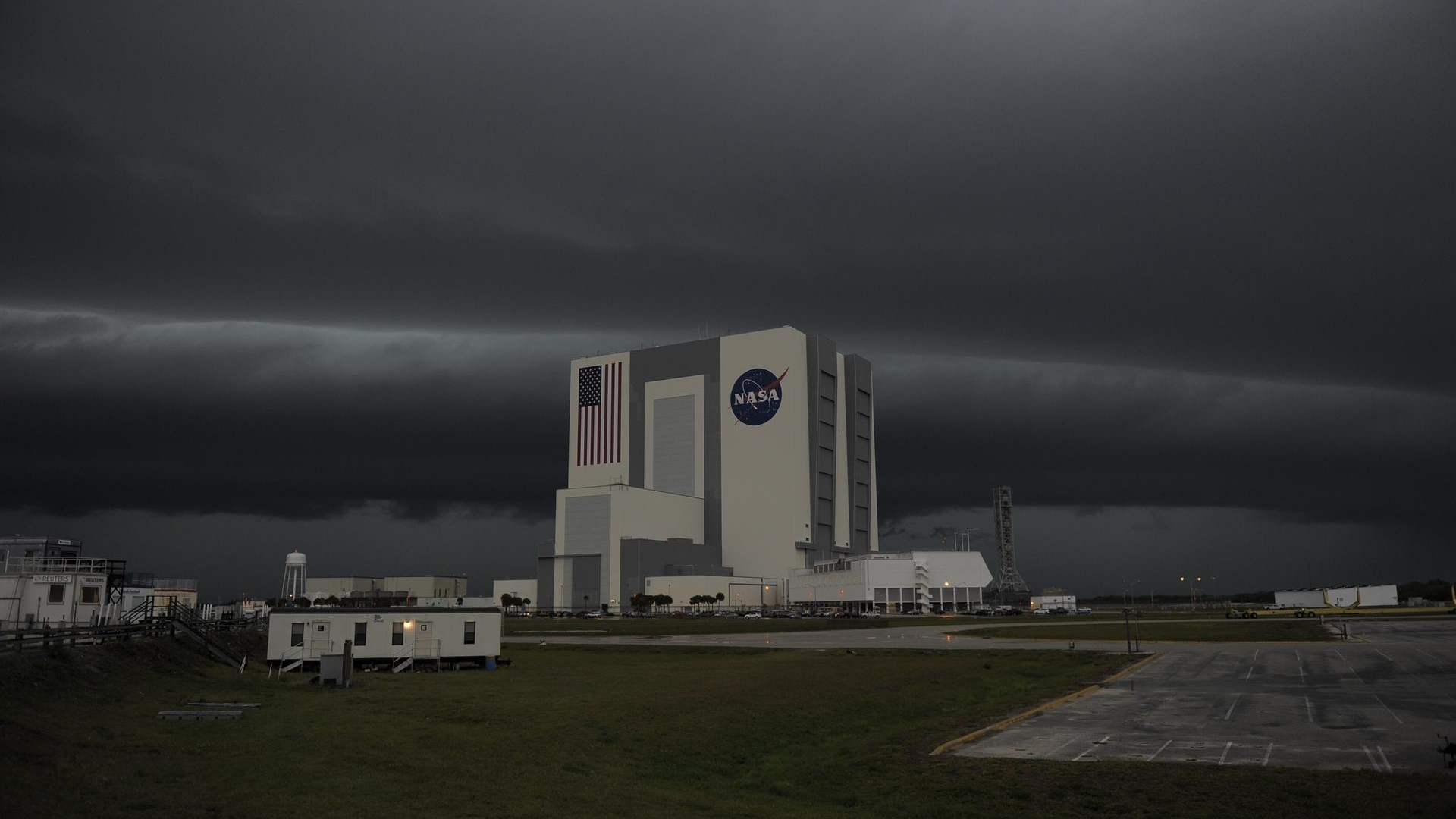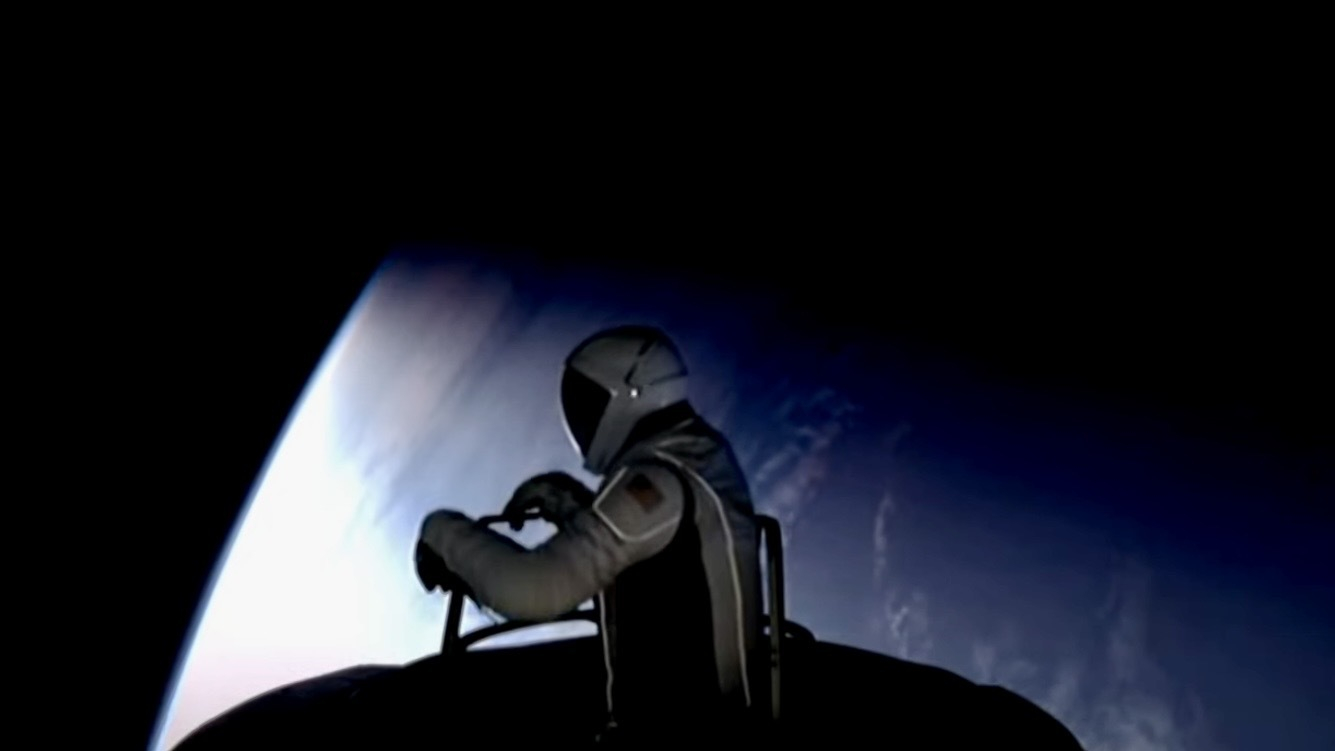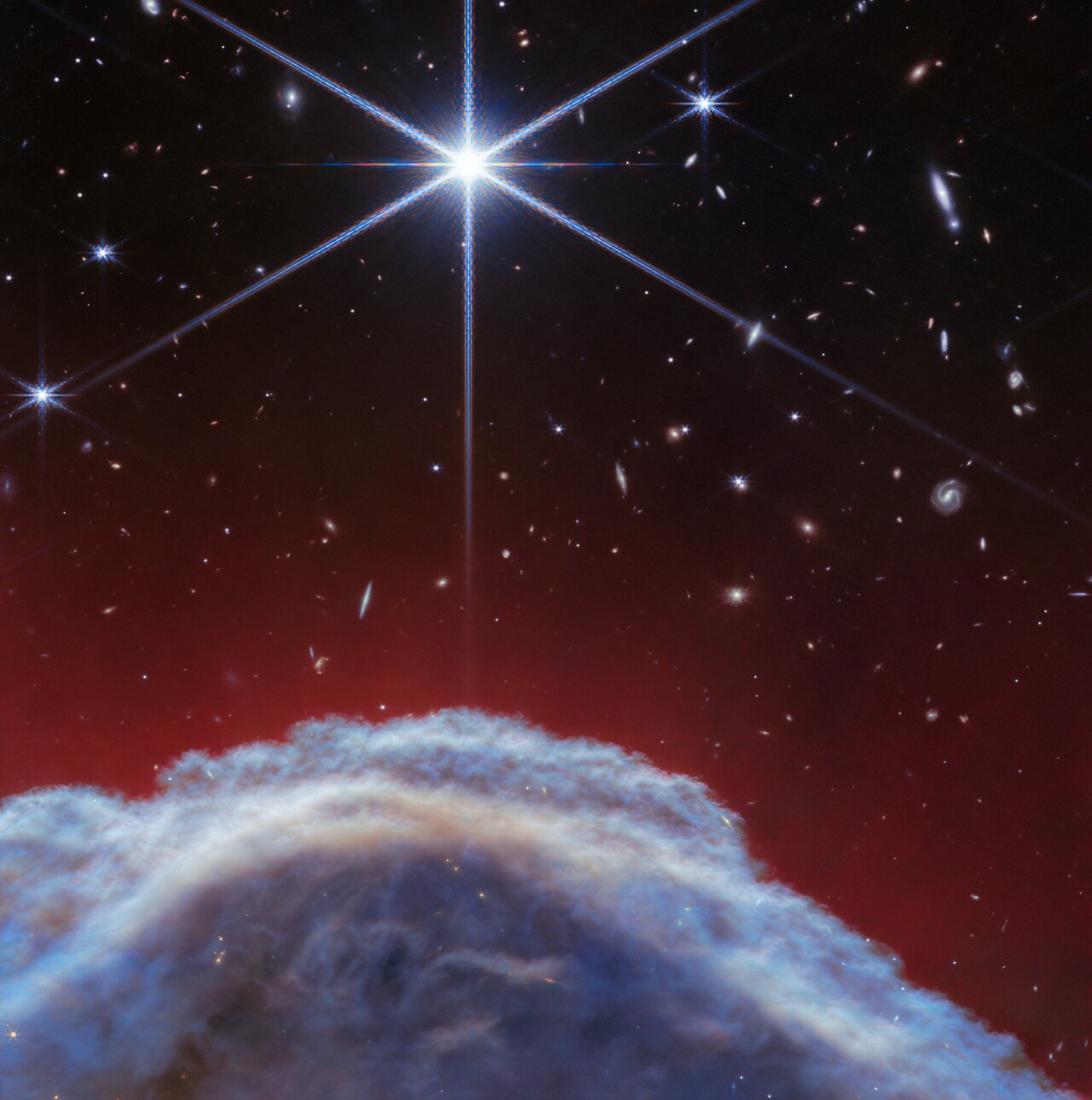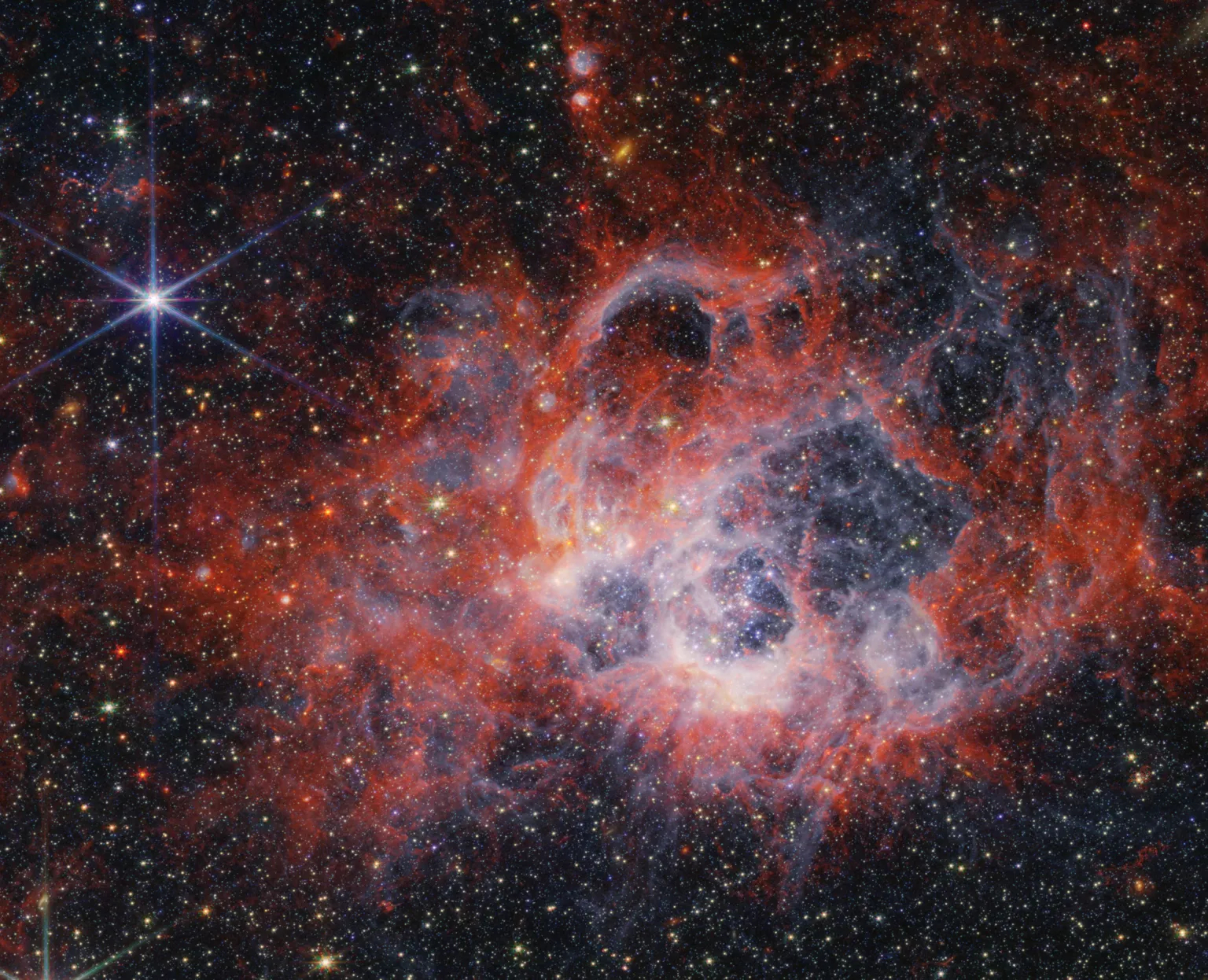The previous yr was a giant one for area.
Skywatchers throughout the USA witnessed a complete photo voltaic eclipse, SpaceX caught a large rocket out of mid-air with a pair of chopstick arms, and telescopes on Earth and in area revealed to us photographs of the universe which have modified our very understanding of the cosmos.
Wish to relive the epic yr in area? Scroll on to see a few of 2024’s most memorable moments.
Starlinks flashing ISS
NASA astronaut Don Pettit shared this picture in November, saying, “Starlink satellites appear like a miniature model of the monolith from ‘2001: A House Odyssey,’ the place the massive flat face of the monolith factors in direction of Earth and the photo voltaic panel protrudes outward just like the fin on the again of a dimetrodon.”
SpaceX has launched tons of of its Starlink satellites over the previous yr, and in a put up on X, Pettit describes the picture’s completely different line streaks. “In comparison with the well-defined streaks from star trails, this time publicity exhibits wonky streaks flashing ISS. These are Starlink satellites reflecting pre-dusk or pre-dawn daylight off their photo voltaic panels. They’re solely seen from 5 to 18 levels previous or trailing the solar. They create brilliant flashes, maybe lasting for a number of seconds every because of the orientation of their outward pointing photo voltaic panels.”
Learn extra: SpaceX Starlink satellites seen as ‘wonky streaks’ by ISS astronaut (images)
Galactic masquerade glares its eyes on Halloween

Like a masks masking two cosmic eyes staring unblinking into the abyss, these two spiral galaxies grazed each other a number of million years in the past, and peered into our souls final Halloween.
This picture’s fiery glare, resembling eyes swirled of their galactic arms, is a mix of mixed-spectrum captures utilizing the James Webb House Telescope for mid-infrared gentle, and the Hubble House Telescope for seen and ultraviolet gentle. On the left, IC 2163, passes simply behind NGC 2207, on the best.
The ATLAS anti-tail

Earth was fortunate sufficient to be graced with comet C/2023 A3 (Tsuchinshan-ATLAS) in October, which was seen to thousands and thousands with the bare eye.
This zoomed-in picture of the comet was taken by astrophotographer Miguel Claro from the Darkish Sky Alqueva reserve in Portugal on Oct. 13, 2024 when the comet was displaying a formidable stage of brightness and particulars, in addition to a cool ‘anti-tail.’
Learn extra: Astrophotographer captures comet Tsuchinshan-ATLAS rising an anti-tail (images)
Tsuchinshan-ATLAS from our personal yard

Although it solely stayed in our skies for a number of weeks, Tsuchinshan-Atlas was already fading towards the tip of October. This picture was shot in Bloomington, Indiana at a farm referred to as Whippoorwill Hill, the place the comet emerged a couple of half hour after sundown, earlier than shortly setting behind the barn pictured right here.
Tremendous Heavy tower catch

The one all of us held our breaths for.
SpaceX launched its 400-foot-tall (122 meters) Starship car for the fifth time ever in mid-October, sending the enormous rocket aloft from its Starbase website in South Texas.
In a world’s first, SpaceX’s Tremendous Heavy executed what seemed to be a bull’s-eye touchdown, hovering close to its Mechazilla launch tower as its metallic “chopstick” arms grabbed it mid-air. This was one you needed to see to imagine.
Learn extra: SpaceX catches large Starship booster with ‘Chopsticks’ on historic Flight 5 rocket launch and touchdown (video)
Northern Lights illuminate the skies over the U.S.

2024 was the yr for the aurora borealis!
Swooping right down to altitudes hardly ever visited by the northern lights, highly effective eruptions of plasma from the solar all through 2024 splashed Earth’s protecting magnetic area with a number of dazzling shows. We’re at the moment experiencing a interval of photo voltaic most, an 11-year cycle of photo voltaic exercise. It is doubtless we could so much more of those occasions in 2025.
Hurricane Milton looms over the VAB

October and September had been additionally arduous months for a lot of, as hurricanes left devastation throughout elements of the USA. This photograph exhibits Hurricane Milton when the storm made its means throughout the state to NASA’s Kennedy House Heart (KSC).
Although the House Coast did not expertise as extreme storm surges and wind speeds as cities like Tampa or Sarasota, KSC was on excessive alert, elevating the bottom standing to HURCON 1 — closing the middle to all however important personnel.
Pink Working Rooster

Extra astrophotography from 2024 included this superb picture from the European Southern Observatory (ESO). Stare deep within the wealthy pink textures of this fuel cloud within the Working Rooster Nebula. The cloudy stellar nursery, IC2948, is barely a small portion of its bigger nebula, however incorporates numerous stars within the early levels of life. This picture was processed from a 1.5-billion-pixel picture taken by the VLT Survey Telescope (VST).
In response to ESO, the part of area within the sky solely takes up about one-third the scale of a full moon, whereas the entire Working Rooster Nebula spans about 25 full moons throughout.
The primary business spacewalk

It was a historic second. Because the solar rose throughout the japanese portion of the USA, miles above, in orbit of the Earth, Jared Isaacman and the Polaris Daybreak crew accomplished the first-ever business spacewalk.
Taking turns exiting their Crew Dragon spacecraft, Isaacman, Polaris Daybreak mission commander, and Sarah Gillis, mission specialist, took turns testing the mobility and performance of SpaceX’s new extravehicular exercise (EVA) spacesuits. Pictured right here, Isaacman floats in Dragon’s open hatch, grabbing the specially-designed Skywalker mobility aide, as he appears to be like down on the Earth beneath.
Learn extra: SpaceX Polaris Daybreak astronauts carry out historic 1st non-public spacewalk in orbit (video)
A Milky Manner marvel over Stonehenge

Photographer Josh Dury captured this positively breathtaking view of this yr’s Perseid meteor bathe above Stonehenge, U.Ok.
In response to Dury, the picture consists of 43 sub-images of the meteors taken over three and a half hours. “Celestial fireworks baring the connection via time. The traditional particles of Comet Swift-Tuttle; fashioned on the early daybreak of our photo voltaic system. Noticed from the traditional palace — chartering the actions of heavenly our bodies. A pertinent narrative via mindless time and thriller,” Dury advised House.com through electronic mail.
Learn extra: Uncommon show of northern lights and Perseid meteor bathe delights skywatchers worldwide (images, video)
Hubble sees a doomed star

This star, Eta Carinae, is anticipated to blow up someday quickly. Perhaps.
The star may even have one other million years to go. However the mass of Eta Carinae implies that when it lastly does go growth, it’ll doubtless be a supernova occasion. The star, one of the huge within the Milky Manner, can also be monstrous sufficient to depart behind a black gap when it dies.
The Hubble House Telescope has been monitoring Eta Carinae for the final quarter of a century, ready for it to lastly bear its demise throes.
Associated: Watch a 180-year-old star eruption unfold in new time-lapse film (video)
Atlas V launches its final House Pressure mission

United Launch Alliance’s (ULA) venerable Atlas V rocket flew its ultimate nationwide safety mission over the summer time. The Atlas V launched from Florida’s Canaveral House Pressure Station July 30, on a categorised mission for the U.S. House Pressure referred to as USSF-51.
It was the final nationwide safety area launch (NSSL) for a member of the Atlas rocket household, which has been flying since 1957. Now, ULA has begun to shift its nationwide safety manifest to the corporate’s new Vulcan rocket.
Learn extra: Atlas V rocket launches its ultimate nationwide safety mission for US navy (video)
The Crab’s claws

A brand new mosaic of the Crab Nebula by the mighty James Webb House Telescope was launched in June. The picture traces the crab’s “claws” in contemporary, beautiful element. This picture revealed detailed cage-like buildings within the nebula, fashioned by numerous mud grains, seen notably prominently as fluffy magenta materials within the higher proper and decrease left.
Starliner seen docked on the Worldwide House Station

The wayward story of Boeing’s Starliner spacecraft and its return to Earth with out its astronaut crew has been properly reported since its launch in June. NASA astronauts Butch Wilmore and Suni Williams flew aboard Starliner to the Worldwide House Station (ISS), the place the pair nonetheless stay, and can properly into 2025.
However, whereas their spacecraft was nonetheless docked to the ISS, Maxar Applied sciences’ WorldView-3 satellite tv for pc managed to zoom means in to identify the automobiles in orbit collectively above Earth. Along with the Starliner capsule, almost all of the ISS modules are clearly seen, in addition to the station’s new upgraded photo voltaic panels.
Touting their imaging capabilities, Maxar Applied sciences shared this superb photograph in a social media put up June 13, saying, “this kind of imagery assortment, referred to as non-Earth imaging (NEI), is a breakthrough functionality that permits Maxar to assist important area area consciousness missions for presidency and business clients.”
Ghostly view of an toddler solar

One other gem from the Hubble House Telescope is that this picture of the toddler star, HP Tau.
At simply 10 million years outdated, HP Tau is the youngest of its neighbors, residing roughly 550 light-years from Earth within the constellation Taurus. Like a younger model of our personal solar, HP Tau, is seen on the high of a trio of glittering stars on this Hubble picture. These stars sparkle from inside a hole cavity in a billowing cloud of fuel and dirt, its thick swirls shining in good blues, like a flashlight chopping via the fog.
Associated: Enchanting new Hubble Telescope picture reveals an toddler star’s sparkle
One other mind-blowing JWST picture

To not be outdone, the James Webb House Telescope (JWST) captured extremely sharp photographs of the Horsehead Nebula in April, one of the iconic celestial our bodies within the sky over Earth.
JWST was in a position to see particulars of the Horsehead Nebula, also referred to as Barnard 33, that had by no means earlier than been revealed, displaying some areas in a very new gentle. The brand new photographs present the Horsehead Nebula as turbulent waves of fuel rise from the western aspect of Orion B, a star-forming molecular cloud situated 1,300 light-years from Earth within the constellation of Orion.
Totality!

April was a giant month for North America, as a complete photo voltaic eclipse swept over a stretch of Mexico, the USA, and Canada hundreds of miles lengthy.
The eclipse was one of many most-watched eclipses ever. All of North America and Central America skilled a partial photo voltaic eclipse, however solely these situated throughout the path of totality — an roughly 115-mile (185-kilometer) large and 10,000-mile-long (16,000 kilometers) route — noticed the moon fully obscure the solar.
Spectacular photographs of the eclipse had been captured alongside the way in which, together with this one from astrophotographer Miguel Claro, who wrote a step-by-step have a look at how such a mesmerizing photo voltaic eclipse photograph was captured.
Eclipse Throughout America

In the course of the complete photo voltaic eclipse on April 8, 2024, the trail of totality crossed 4 states in Mexico (Sinaloa, Nayarit, Durango and Coahuila) earlier than sweeping over 15 U.S. states (Texas, Oklahoma, Arkansas, Missouri, Illinois, Kentucky, Tennessee, Michigan, Indiana, Ohio, Pennsylvania, New York, Vermont, New Hampshire, and Maine) and 7 Canadian Provinces (Ontario, Quebec, New Brunswick, Prince Edward Island, Nova Scotia and Newfoundland).
Pictured above is the quaint downtown of Bloomington, Indiana beneath a development of the solar and moon into and out of totality. Scenes like this had been watched in tons of of small cities and cities because the uncommon celestial occasion moved throughout the sky.
About yesterday…

My favourite photograph of the eclipse, humbly, is that this one I took throughout totality. This was shot because the solar’s rays had been peaking out from behind the moon to create a “diamond ring” impact.
In that second, I took benefit of the chance to drag out a diamond ring of my very own, and ask my associate to marry me. She stated, “Sure!” For sure, some fairly unimaginable moments had been captured through the complete photo voltaic eclipse of 2024.
Our galactic middle

Additionally in 2024, astronomers captured the primary view of polarized gentle and magnetic fields that encompass Sagittarius A* (Sgr A*), the supermassive black gap on the coronary heart of our Milly Manner galaxy.
The historic commentary was made with the Occasion Horizon Telescope (EHT), and revealed magnetic area similarities with these surrounding the supermassive black gap on the coronary heart of the galaxy M87.
SpaceX’s Starship Soars on Flight 3

March 2024 noticed the epic third take a look at flight of SpaceX’s Starship megarocket. The 400-foot-tall rocket soared above the southernmost level in Texas as spectators cheered on from seashores, boats and rooftops in close by cities and cities.
SpaceX conduced 4 Starship launches in 2024, and has many extra deliberate for subsequent yr. The rocket firm is hoping to launch Starship at the least 25 instances subsequent yr, after petitioning the Federal Aviation Administration for in enhance within the rocket’s launch frequency.
Star nursery tendrils

One other JWST marvel from 2024 was this picture, taken by the telescope’s NIRcam instrument. It exhibits a near-infrared view of a star-forming area referred to as NGC 604, which sits within the Triangulum galaxy 2.7 million light-years from Earth. The picture exhibits arms of fuel and dirt, which shelter greater than 200 of the most popular and most huge kinds of stars.
A final have a look at Ingenuity

NASA’s Ingenuity was formally grounded after its final flight on Jan. 18, this yr. However the little Mars-copter-that-could lasted properly past its mission parameters and the expectations of its operators.
Blowing previous the mission’s 5 preliminary flights, Ingenuity accomplished a complete of 72 flights on the purple planet earlier than lastly calling it quits. This picture was shot by NASA’s Perseverance rover, because the Martian explorer strikes out of vary of Ingenuity.
Gone however not forgotten, Ingenuity accomplished the primary flight of a powered plane on a planet apart from Earth, and impressed extra plans for helicopter drones to be despatched to Mars. Lately, NASA revealed that Ingenuity had “one ultimate reward” to offer. The downed copter will proceed on as a climate station, recording telemetry, taking photographs and storing them on board.
Stage separation to the moon!

The fiery tear within the wealthy, darkish blue of the evening sky on this {photograph} captured by Trevor Mahlman in February, is a SpaceX Falcon 9 rocket, captured through the moments of stage separation because the car’s predominant booster burns again towards Earth and the second stage streaks onward to area.
This launch occurred early in morning February 15, lifting off from Pad 39A, at NASA’s Kennedy House Heart, in Florida. The payload was Intuitive Machines’ “Odysseus” Nova-C moon lander, which made historical past as the primary business mission to landing on the lunar floor.
So, there you could have it. Twenty-four area photographs for 2024. Subsequent yr is shaping up for much more discovery, spaceflight, sky watching and astrophotography. So, as all the time, maintain trying up.
Submit your story images! In case you seize an unimaginable area photograph and wish to share it with House.com’s readers, ship images, movies, feedback, and your identify, location and content material utilization permission launch to spacephotos@area.com.





